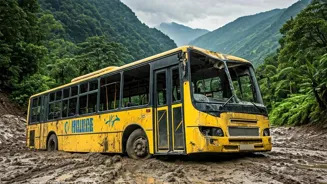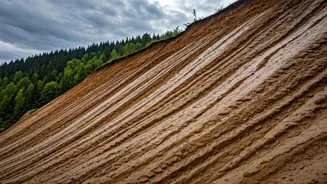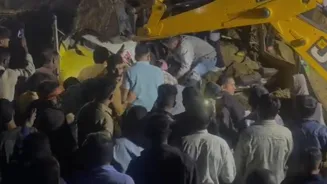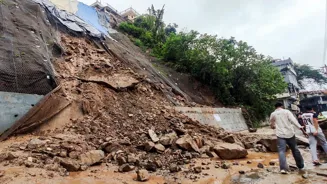The Devastating Landslide
The relentless downpour in Himachal Pradesh led to a catastrophic landslide, a natural disaster that occurred and resulted in significant loss of life.
The incident, which unfolded when the landslide struck a bus, claimed the lives of 15 people. The area was already saturated due to the continuous heavy rainfall, making the slopes unstable. The force of the landslide was immense, sweeping away the bus and leading to the tragic consequences. This underscores the unpredictable nature of weather events and the potential dangers they pose, particularly in mountainous regions prone to landslides. The aftermath of the landslide required immediate rescue operations and support for the affected families. Authorities were quick to respond, coordinating efforts to recover the victims and provide assistance to those impacted by the tragedy. The event also emphasized the importance of preparedness and infrastructure in disaster-prone regions to minimize the impact of such occurrences.
Causes and Consequences
The primary trigger for the landslide was the persistent heavy rainfall that had been battering Himachal Pradesh. The saturation of the soil weakened the slopes, making them susceptible to collapse. This is a common phenomenon in mountainous regions during monsoon season, where the combination of steep terrain and excessive rainfall creates ideal conditions for landslides. The consequences of the landslide were devastating, with the loss of 15 lives representing a profound tragedy. Beyond the immediate loss of life, such events can also cause extensive damage to infrastructure, including roads, bridges, and buildings, further disrupting daily life in affected areas. The emotional toll on the families and communities impacted by the landslide is immeasurable, emphasizing the need for comprehensive support and long-term assistance to help them cope with the aftermath. The incident highlights the critical need for effective early warning systems and disaster management protocols to mitigate the impact of similar events in the future.
Rescue and Response
Following the landslide, rescue operations were immediately launched to search for survivors and recover any bodies. The local authorities and emergency services worked tirelessly, deploying teams to the site to assess the situation and begin the rescue efforts. These operations were often hampered by the ongoing rain and the unstable terrain, adding to the challenges faced by rescuers. The rescue efforts involved the use of specialized equipment, such as excavators and other machinery, to clear debris and reach those who might be trapped. The response also included the mobilization of medical teams to provide immediate assistance to any survivors and to offer support to the injured. The coordinated response highlighted the resilience and determination of the local communities and the emergency responders in the face of adversity. Post-rescue, efforts focused on providing support to the affected families and assessing the extent of the damage, ensuring that all the necessary resources were in place to provide aid.
Prevention and Mitigation
To reduce the likelihood of future such incidents, preventive measures and mitigation strategies are crucial. These strategies involve a range of approaches, including improved infrastructure development, improved early warning systems and effective land use planning. Infrastructure improvements might involve reinforcing vulnerable slopes with retaining walls or drainage systems to prevent soil erosion. Installing an advanced early warning system is a necessary step, which provides authorities and residents with advance notice, thus allowing for timely evacuations and safety measures. Comprehensive land use planning is critical; the regulation of construction in high-risk areas, such as steep slopes, is an important way to minimise risk. Moreover, community awareness programs can educate residents about the dangers of landslides and promote preparedness. These collective efforts will aim to lessen the number of future disasters and create safer communities.














